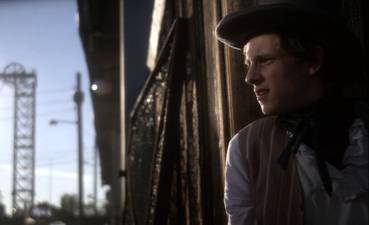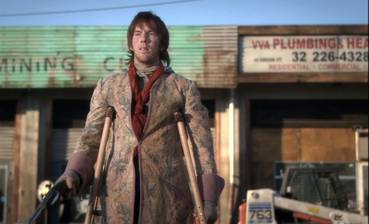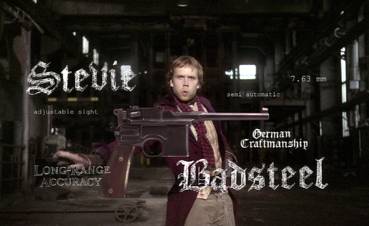|
Let's
get one thing straight so you know where my bias lies.
I firmly believe that Lars von Trier and Thomas Vinterberg
are two of the most talented and important filmmakers of
the modern age. Between them they founded a film movement
(Dogme 95 – did you really need to be told that?) whose
influence on subsequent cinema and even television is almost
incalculable. Vinterberg's Festen was the
first and best of the official Dogme films and von Trier
has made a string of remarkable and often confrontational
works that have divided opinion like no other modern director. So the prospect of a collaboration between the two,
Vinterberg directing from a von Trier script, was always
an exciting one. Upping the ante even further was the news
that the film was to be a critique of gun culture and set
in small-town America, inevitably recalling the devastating
impact of von Trier's Dogville.
Could the film really live up to a build-up like that? Well,
no. Don't get me wrong, Dear Wendy is a
bloody fine film in many respects, but... well, let me explain.
It's all about guns, and more specifically, what people
do with them.
Firearms
are central to Dear Wendy, which kicks
off enigmatically with a group of youngsters, dressed
largely in a hodge-podge of historical garments, loading
up a variety of firearms for our examination. In voice over, one of them starts reciting
what sounds like a love letter to a girl named Wendy, who
is initially akin to Samuel Beckett's Godot, repeatedly referred to but not
shown, at least for the first twenty minutes of the film. That said, if you haven't
guessed her identity five minutes in then you probably need to see
more movies. Following this prologue, we jump back to the
start of the story, as young, unsociable Dick, who has been talked into
attending a birthday party by the family's good natured maid Clarabelle, buys a toy gun at a local store
manned by shy, similarly aged Susan. Deciding to keep the
weapon, he is surprised when quiet work colleague Stevie
informs him that the gun is real, and even constructs a
bullet so that he can try the weapon out. Initially reluctant, he is
so liberated by the experience of firing it that
he proposes the formation of a group uniting all of the
town's misfit youngsters. Calling themselves The Dandys,
they each select a specific gun to match their adopted personality,
but as an essentially pacifist group they decree that though
their guns can be carried as confidence boosters, they can
only be fired in the old warehouse that they use as a home
base, and never at people.

The real world love of guns extends far beyond the shores of America,
but has a particular resonance there through the constitutional
right to bear arms and the famed cry of the NRA, whose members
proclaim that the only way you'll take their weapon is to
prise it from their cold, dead hands. Dear
Wendy literalises this love affair by pairing each
of the Dandies with their chosen weapon on a deep emotional level,
life-long lovers who are joined in symbolic marriage ceremonies,
though the secrecy of these relationships is more suggestive
of illicit affairs. They even explore the attraction on
a more complex level by studying weapons, firing patterns,
the destructive effects of exit wounds, and the power of
self-inflicted pain to promote a fearlessness in battle. As
the narrator, Dick remains throughout the film's central
figure, but his relationship with his treasured gun is threatened
by the arrival of Sebastian, whose own fascination with
the weapon sparks a jealousy that ultimately casts the
gun itself in the role of unfaithful partner.
All
of which is well and good, but this is not the film's underlying
theme so much as its clearly proclaimed raison d'être,
resulting in a film that wears its subtext on its sleeve
and creates the sense of a tale that the storyteller believes
he is whispering but which can be heard from halfway across town.
Certainly the sexual element of the human/gun relationship
dates back to Freud, and has been toyed with in films from
Bonnie and Clyde to The Enforcer
and beyond. The idea of a gun as surrogate female partner
was a memorable aspect of Full Metal Jacket
(and especially the self-destruction of Private Pile), and
was most directly explored in Ashley James King's now impossible-to-see short
film Seduction, in which a man's deadly
relationship with a glamorous blonde climaxes with a suicidal
stand-off with armed police and the revelation that the
woman is actually a handgun, compressing key components of
Dear Wendy's feature length story down
into an economical 5 minutes of screen time.
Other
subtextual elements are woven into the mix, from the social
paranoia associated with the fear of rising crime to issues of
power-inspired confidence and the disillusionment and disappointment
of youth. Indeed, the film says a little about quite a lot,
but a lot about very little, touching on elements rather
than exploring them in depth. This seems to have
been deliberate, with Vinterberg himself suggesting that the
film was intended to provide no answers, just to provoke
debate, though one he will presumably not be involved in.
That the Dandies themselves are all effectively outsiders,
misfits in a society in which even they describe themselves
as losers, conforms a little too readily to the favourite
media stereotype of unsociable, introspective victim who
finds power and expression through violent action. This
still makes for interesting cross-reading, however – with
their costumes and props and secret signs and congratulatory
"Brideshead stutter," this group could just as
easily be Trekkies or role-players or bikers, or a thousand
and one other groups that society at large will happily
label as odd, but which for its members provides a sense
of identity and belonging.

It
may play at times like the Beginner's Guide to Subtextual
Cinema, but in other respects Dear Wendy
is an involving and sometimes inventive work, with quietly
engaging performances from its largely young cast (Jamie
Bell, Mark Webber, Danso Gordon, Michael Angarano and especially
Chris Owen and Alison Pill), some effective post-modernist
touches (borrowing tricks from Oldboy and
Three Kings, and even offering a passing
nod to Dogville) and some nifty work from
Vinterberg and his crew, creating a sense of drifting timescales
through costume, set design and repeated visual references
to the Old West. It is a collage of intriguing ideas, neither
as focussed or as powerful as von Trier's own Dogville
or even Michael Moore's documentary examination of gun culture
Bowling for Columbine. It nonetheless engages
on an emotional level enough for us to really feel for the
Dandies when things, as they are destined to do from the
start, take a darker turn. The climactic stand-off, triggered
by a genuinely unexpected moment of jarring violence, is
compelling cinema – startling, intelligent, tragic and above
all moving, it's message may not be new, but is nonetheless
delivered with considerable style and appropriate impact,
and climaxes on a note that would have filled Freud with
glee.
A
testament to just how good HD video can look when transferred
to film, the picture here is absolutely first rate, with
colours, contrast and detail close to perfect, and had I
not seen the untreated footage (see the extras for this)
with my own eyes I would have sworn this was shot on film.
The framing is a slightly unusual 1.65:1 and is anamophically
enhanced.
An
unflashy but very nice 5.1 mix very effectively creates
a sense of place through a strong use of ambient sound and
effects, which really come into their own during the climactic
confrontation, and use the entire sound stage to arresting
effect. Music and dialogue are crystal clear throughout.
A
decent collection of extras borrowed from the Danish Nordisk
release kicks off not in the Extras section, but in the
Setup menu, where you will find a commentary by director Thomas Vinterberg and DoP Anthony Dodd Mantel.
It gets off to a fairly deadly start, with both men hesitant
about getting going and then simply pointing out what we
can see on screen, but quickly improves to cover the collaborative
process between von Trier and Vinterberg, the work of the
actors, the origins of Dandyism, the potential racial readings
of Sebastian's character, and a few interesting on-set (or
in one case in hotel) anecdotes. There is, though, a lot
of discussion on the subtextual reading of particular scenes,
which even the least deconstructive viewer should be able
to process without help.

Also
on the Setup menu you will find 9 Letters to
Dear Wendy, short spoken letters from the
cast and the director (the longest is 3:26) recording their
experiences on the film, recorded at various stages of the
production, accompanied by a sequence of the film in which
they (when the actors are speaking) figure. These are all
interesting, though this is largely a yahoo for the very
positive experience the film seems to have been for everyone.
Extracts from these appear in the next extra.
Letters
to Dear Wendy (25:01) is a behind-the-scenes
documentary of considerable interest, covering the construction
of the sets, the introduction of the actors to their respective
guns and firearms in general, and the location shift to
Germany for the factory interior scenes. There are plenty
of interviews with cast and crew members, and extracts from
the Dear Wendy letters also featured on the disk.
The
Director and Screenwriter (16:50) is an interview
with Lars von Trier and Thomas Vinterberg, part of which
is incorporated into the Letters to Dear Wendy
documentary. They discuss their collaboration on the film,
the differences in their respective approaches, what happens
to the human body when it's shot and the widespread fascination
with guns. In Danish with removable English subtitles.
The
UK-US Teaser (0:55) plays up
the film's postmodernist use of graphics, but is an intriguing
enough sell.
The
UK-US Trailer (1:59) follows
more traditional lines, over-emphasising the disruptive
arrival of Sebastian to the group and his conflict with
Dick.
Trailer
(1:43) is along similar lines to the immediately above,
but slightly more inventive in its editing.
TV
Spot (0:41) compresses elements from the above
and plays up the action elements.
There
are 5 Deleted Scenes: Guess
the Gun (4:10) includes some flirting between Sebastian
and Susan and some real verbal conflict between Sebastian
and Dick, one shot from which appears in the trailers; Sebastian's
Baptism (1:29) emphasises the ritualistic aspect of
the group's human/gun relationship and overstates the jealousy/betrayal
element triggered by Sebastian's arrival. Second Parade
(1:23) features some more Electric Parc Square celebratory
dancing – the film's video origins are more evident here.
Marshall Walker (2:15) expands on Walker's communication
with Sheriff Krugsby (Bill Pullman), showing him in the
back of his car rather than as a disembodied voice. Original
Script Ending (7:26) is compiled from a combination
of processed footage and original HD material, and includes
one significant change that also explains the mysterious
appearance in the road of a particular object in the final
scene (well, sort of), an extended version of the final
interior set-up and a post-ending conclusion. All have optional
(partial) commentary by Vinterberg and editor Mikkel E.G.,
which is conducted in English and explains why and when
the scenes were removed.
Poster
Artwork is a nicely done gallery of posters
for the film that can be browsed through, or individual
posters can selected via large thumbnails and enlarged close to full screen.
It
is somewhat inevitable that some will read Dear
Wendy as another Lars von Trier penned attack on
aspects American society, but as Vinterberg points out on
the commentary, the human love affair with guns is an almost
world-wide issue and not specific to any one country (though
the fact that von Trier repeatedly chooses to set his critiques
of human behaviour in the USA can't help but raise questioning
eyebrows). In that respect, Dear Wendy has a great deal going for it, as what it has to say is
both relevant and absolutely worth saying, even if it does
say it in sometimes overly literal terms. As drama it is
involving stuff, is very well made and acted and absolutely
deserves to be widely seen and, yes, discussed, just as
Vinterberg and von Trier wanted. And Metrodome's DVD is
good place to start the debate, being essentially a port
of the Danish Nordisk release, with fine picture and sound
and all of that disk's extras, only now you don't have to
navigate a Danish DVD site to get it.
|